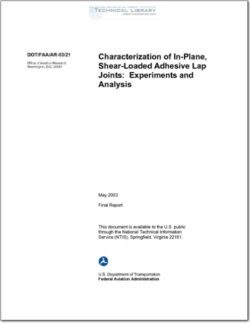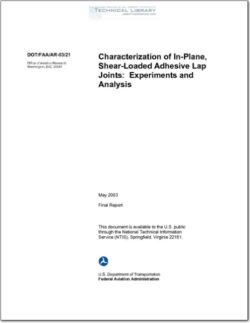DOT-FAA-AR-03-21

- Version
- 288 Downloads
- 8.21 MB File Size
- 1 File Count
- March 24, 2016 Create Date
- March 24, 2016 Last Updated
Characterizationof In-Plane Shear-Loaded Adhesive Lap Joints

The growing applications of adhesive bonding in aircraft structures require that more emphasis
be placed on analytical models to predict failure and load carrying capability. As these analytical
models become available, they must also be validated with experimental testing. In this
experimental investigation, failure strengths of in-plane, shear-loaded bonded joints were
compared with analytical predictions of the Shear-Loaded Bonded Joint (SLBJ) theory. The
investigation was carried out in two phases. Phase I was conducted with a particular focus
placed on the effect of bondline thickness on joint strength. Phase I specimens were fabricated
using E—glass/epoxy cloth and PTM&W E86292 two-component paste adhesive. A box beam
torsion test fixture was used to apply a shear loading. Phase II was carried out to investigate
changes in adhesive and adherend properties on SLBJ predictions. Phase 11 specimens were
fabricated using aluminum and carbon adherends with Loctite and Hysol EA9360 paste
adhesives.
Several joggle (production-style) joints were tested to investigate the effects of joggle
adherend on the strength of the adhesive joint. A failure analysis was conducted to study the
failure mechanism of these joints. Experimental data and SLBJ predictions indicated a decrease
in strength as the bondline thickness was increased. SLBJ predictions for thin bondlines were
comparable with experimental data, but for thick bondlines, the SLBJ predictions were lower
than the experimental data. Experimental data in this investigation revealed the significance of
adhesive characterization and the adhesive joint characterization. When predicting failure of the
joint, one must pay attention to the failure mode because it largely contributes to the joint
performance. Because SLBJ predictions were based on the adhesive plastic strain, assuming
linear elastic behavior of the adherend, the validity of these predictions were limited to the joints
with adhesive or cohesive failure with minimal nonlinearity of adherend materials. When these
conditions were met, the SLBJ model showed good correlation with the experimental results.
| File | Action |
|---|---|
| DOT-FAA-AR-03-21 Characterizationof In-Plane Shear-Loaded Adhesive Lap Joints.pdf | Download |
Comment On This Post